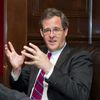
My 17-year-old just graduated last week from one of the best private prep schools in New York City. Until ninth grade we were avowedly public school people and my son was one of the few in his class of 180 middle schoolers that decided to veer off into New York's expensive and competitive private high schools.
He had some very good public options: he qualified for one of the best specialized public high schools in the country and he also got into a very strong neighborhood public high school where many of his middle school friends went.
The decision to go private was largely influenced by us, his parents, and by one classmate who was also going to private school: "Your parents are willing to send you to private school and you don't want to go? What are you, crazy? Those public school buildings are lousy and have no sports facilities."
It was his friend's influence -- perhaps right for the wrong reasons -- that made our son come around and we boldly marched in unanimity into the cold, untested waters of private education in 2008.
I'm reminded of what Warren Buffet once wisely said about how to improve public education in America: require the president of the United States, his cabinet members and every official in Washington, D.C. to send their kids to public school. You'll then see, he said, how quickly public education is fixed.
At the time we applied to a nearby private school -- Fall 2007 -- the world looked like a safe place financially, and the idea of a $30,000+ tuition seemed manageable for our family.
But then came Lehman Brothers, the near depression and those like us, who took the six-figure plunge on private high school started questioning the wisdom of our decision.
All these thoughts came flooding back to me last week when we went to a small reunion of my son's middle school friends in Central Park. The four graduating seniors who joined us -- two who went on to public schools and the other two to private -- spoke with candor about their high school experiences as I discreetly listened in, one ear trained on their conversation and the other on the parents socializing.
The private school kids were largely enthusiastic about their education and thought they had many good teachers; the public school teens were more critical of their school and the erratic nature of their instructors. One public school parent chimed in: "My son went to a factory and we won't let his sister do the same." This parent's son went to the public high school my son turned down, and I felt a guilty satisfaction at this mom's indictment of that school because, for us, it was a road not taken.
This got me thinking about the divide that still exists between good private schools and good public schools. What are the main differences? Well, class size is a big one. My son had classes of 12-15 kids and much teacher attention; his public school friends were in classes of 32-35. A great teacher can surmount this disparity but, as we know, great teachers in public schools these days are in short supply. Half of public school teachers leave the system in their first five years and very few have the requisite clinical training or mentoring to become great teachers.
There is also the facilities that my son's friend badgered him about four years ago. The school gym, the pool, the well-equipped classrooms and theater arts department were far superior at my son's school to the same facilities at the 3,000-student public school we passed up.
So, what to do? We can't just continue to throw up our hands and say, oh well, that's the way it has been for awhile: wealthier parents can get superior secondary educations for their kids.
We must give every public school kid a private school-quality education. We must put more money into teachers and teacher training and less into administration and expensive outsourcing of testing and other unnecessary evaluation programs. We need to bring public class sizes down to no more than 25 students and we need to make sure the facilities -- gyms, auditoriums, science labs, just to name a few -- are top notch.
My family made a private decision four years ago that in retrospect, was the right one. Even my son acknowledges that today. And despite my depleted retirement savings, I am content that my son got the best education to suit his personality and needs.
But we are the lucky ones who had a choice. No one should have to make a purely private decision when deciding what school is best for their child. We need to discuss this publicly and come up with private-school solutions for public education.
Charter schools, innovative public school programs, specialized and gifted education programs as well as an increased emphasis on career and technology education for high school students is necessary for our city and country to prepare students for 21st century jobs and the increasingly intense competition in the global job market.
Let's begin this public discussion of what is working and how to make sure every student feels they have great teachers and great school facilities. My private journey has led me to realize that this is the most important issue our city and country now faces.
Tom Allon, a former English teacher at Stuyvesant High School and the father of three teenagers, is a 2013 liberal and Democratic candidate for mayor of New York City.
Join Tom Allon on Facebook.
